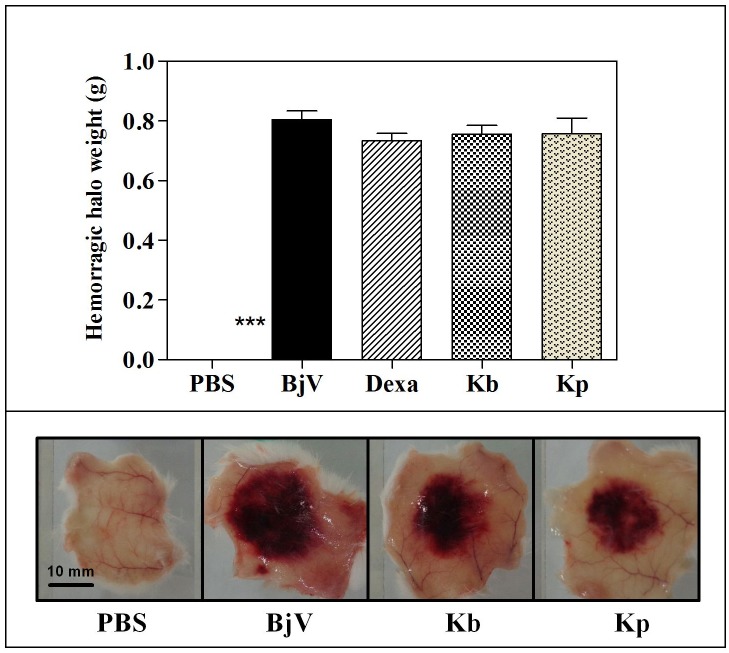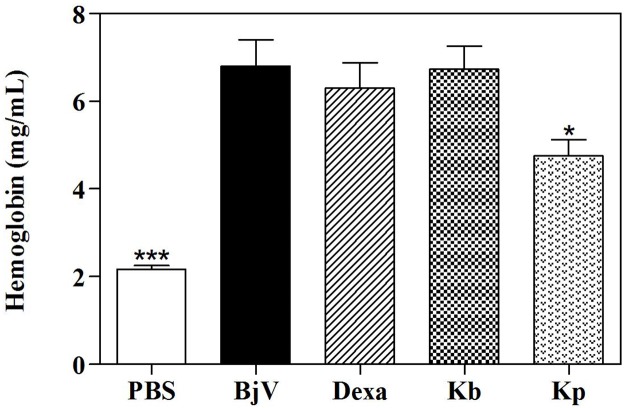The image for Fig 4 is a duplicate of the image for Fig 6. Please see the correct Fig 4 here.
Fig 4. Inhibition of the hemorrhagic activity of B. jararaca (BiV) venom by extracts of K. brasiliensis (Kb) (A) and K pinnata (Kp) (B) in post-treatment protocol.
BjV was injected s.c. in the ventral region of 5 mice before treatement with extract (500 mg/kg, i.p.). Three hours after venom injection, the skin was removed and weighed. The columns represent the mean ± SEM (n = 5). ***p<0.001 compared to venom alone (one-way ANOVA followed by the Tukey’s test).
The image for Fig 5 is a duplicate of the image for Fig 8. Please see the correct Fig 5 here.
Fig 5. Inhibition of B. jararaca (BjV) venom-induced hemoglobin accumulation by extracts of K. brasiliensis (Kb) (A) and K. pinnata (Kp) (B) in post-treatment protocol.
The percentage of activity presented was calculated as: [(Hemoglobin content in animals receiving venom plus extract ÷ Hemoglobin content in animals receiving venom alone) x 100]. Values expressed as mean ± SEM (n = 5). *p<0.05 and ***p<0.001 compared to venom alone (BjV) (100% of activity) (one-way ANOVA followed by the Tukey’s test).
In the figure title of Fig 6, the word Brasiliensis should be lowercase. Please see the corrected caption here.
Fig 6. Inhibition of the edematogenic activity of B. jararaca venom (BjV) by extracts of K. brasiliensis (Kb) (A) and K. pinnata (Kp) (B) in pre-treatment protocol.
BjV was injected i.pl. in the right hind paw of mice pre-treated i.p. with different extracts. Paw thickness was measured during 120 min after venom injection. Edema was expressed as the increase in paw thickness calculated as the percentage difference between the paw thickness after (at respective time) and before (basal values) venom injection. The points represent the mean ± SEM (n = 5). *p<0.05, **p<0.01 and ***p<0.001 compared to the group receiving venom alone along with the i.p. injection of 5% castor oil in PBS (Two-way ANOVA followed by the Bonferroni test).
The image for the S1 Fig is incorrect. Please see the correct image for the S1 Fig here.
Supporting information
Photography by Júlia Morais Fernandes. doi:10.1371/journal.pone.0168658.s001.
(JPG)
Reference
- 1.Fernandes JM, Félix-Silva J, da Cunha LM, Gomes JAdS, Siqueira EMdS, Gimenes LP, et al. (2016) Inhibitory Effects of Hydroethanolic Leaf Extracts of Kalanchoe brasiliensis and Kalanchoe pinnata (Crassulaceae) against Local Effects Induced by Bothrops jararaca Snake Venom. PLOS ONE 11(12): e0168658 doi: 10.1371/journal.pone.0168658 [DOI] [PMC free article] [PubMed] [Google Scholar]
Associated Data
This section collects any data citations, data availability statements, or supplementary materials included in this article.
Supplementary Materials
Photography by Júlia Morais Fernandes. doi:10.1371/journal.pone.0168658.s001.
(JPG)





